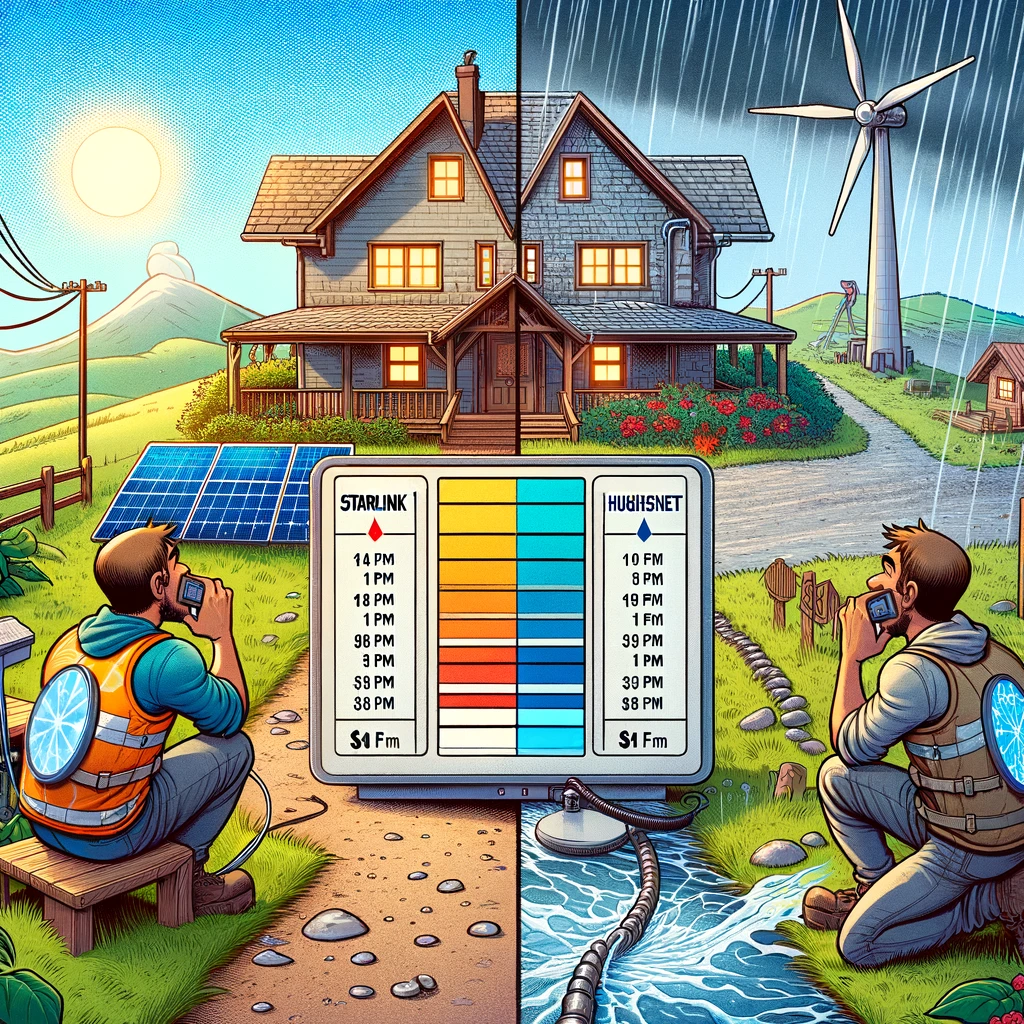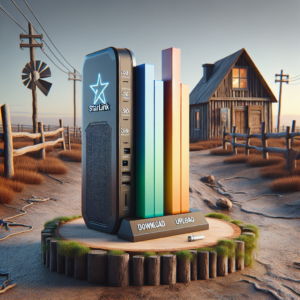
Key Takeaways
Starlink is leading with faster speeds and lower latency, ideal for activities like streaming and gaming.
Hughesnet provides a more consistent service with wider availability, making it a reliable choice.
Weather can significantly affect satellite internet performance, with Starlink being more susceptible to interruptions.
Both providers have data limitations, but Starlink offers an unlimited data option at a higher cost.
Installation and equipment requirements differ between the two services, with Starlink being more user-friendly.
Connecting the Countryside: Starlink versus Hughesnet in Rural Landscapes
Living in the countryside comes with its charms and challenges, and one of those challenges is finding a reliable internet connection. It’s crucial to have access to information, especially in today’s connected world. So, let’s dive straight into the world of satellite internet and compare two major players: Starlink and Hughesnet.
When you’re out in the rural areas, your internet options can be limited. But thanks to satellite technology, you’re not completely out of luck. Two big names are often mentioned: Starlink, a newer player with some impressive tech, and Hughesnet, a long-standing provider with a solid track record. Here, we’ll explore how they stack up against each other.
Median Speeds at a Glance
Speed is often the first thing you’ll hear about when comparing internet services. Starlink has made headlines with its high-speed offerings, often surpassing traditional broadband speeds. On the other hand, Hughesnet provides more modest speeds but with the benefit of wider coverage. For many rural residents, Hughesnet’s consistent service is a lifeline.
Let’s put it into perspective with some numbers:
Provider | Median Download Speed | Median Upload Speed | Latency |
|---|---|---|---|
Starlink | 100 Mbps | 20 Mbps | 20-40 ms |
Hughesnet | 25 Mbps | 3 Mbps | 600 ms |
These numbers show a clear distinction in performance, but remember, the best choice depends on your specific needs and location.
Satellite Internet: A Rural Gamechanger?
For rural users, satellite internet isn’t just about surfing the web. It’s about connecting to the world, managing businesses, accessing education, and more. Both Starlink and Hughesnet have made strides in turning rural internet deserts into oases of connectivity. Yet, the technology isn’t perfect and weather plays a big role in that.
When choosing a satellite internet provider, consider not just the speeds but also the reliability during different weather conditions. This is especially important if you rely on the internet for critical communications.
Hughesnet’s Performance in Harsh Weather
When it comes to satellite internet, weather can be a big deal. Hughesnet has been around long enough to understand this, and they’ve engineered their service to withstand the common weather challenges faced in rural areas. Their satellites sit in geostationary orbit, which means they are positioned to stay in the same spot relative to the Earth’s surface, minimizing potential disruptions caused by atmospheric changes.
However, heavy rain or snow can still impact the signal, leading to what’s known as ‘rain fade’. Hughesnet combats this with built-in technologies that adjust the signal to keep you connected even when the weather gets tough. This doesn’t mean the service is immune to weather-related issues, but it does mean that Hughesnet has experience in maintaining service stability in adverse conditions.
Deep Dive into Speed Test Results
When we look closer at speed tests, we’re not just talking about how fast you can download a movie. It’s about the day-to-day activities you do online. Can you video chat without freezing? Will your online gaming session be lag-free? Speed test results for Starlink and Hughesnet tell us a lot about the user experience.
Starlink, with its low-Earth orbit satellites, typically shows faster speed test results, making it a strong contender for those who need higher bandwidth for tasks like HD streaming or online gaming. Hughesnet’s speed test results are generally slower, but for regular web browsing, checking emails, and streaming music, it’s quite sufficient.
Data Caps and Throttling: How They Affect You
Now, let’s talk about data caps. Both Starlink and Hughesnet have policies around data usage, but they handle them differently. With Hughesnet, you have a set amount of High-Speed Data each month. Once you hit that cap, your speeds will be throttled, but you won’t be charged extra. This can be a pain if you’re a heavy internet user, but it’s predictable and manageable.
“With Starlink, currently, there are no hard data caps. However, the company has mentioned the possibility of prioritizing users’ traffic based on usage, to improve the network for everyone. This means that during peak hours, if you’re a heavy user, your speeds might temporarily slow down.”
Choosing between the two services will depend on your internet habits. If you’re someone who enjoys streaming in 4K or downloading large files, Starlink’s lack of hard data caps might be more appealing. On the flip side, if you’re a light user, Hughesnet’s predictable data cap won’t be much of an issue.
Latency Issues: More Than Just a Number
“Latency is the time it takes for a signal to travel from your device to the satellite and back down to the ground. Lower numbers mean less delay. Starlink boasts latency figures that rival ground-based broadband, whereas Hughesnet’s latency is higher due to its geostationary satellites.”
Latency affects everything you do online. From opening a webpage to playing a fast-paced online game, lower latency makes for a smoother experience. Starlink’s advanced satellite constellation provides an advantage here, but remember, high latency doesn’t mean Hughesnet is out of the race—it’s still a viable option for many users, especially those with fewer demands for real-time interaction.

Choosing Wisely: What Rural Users Need to Know
Making the right choice for rural internet requires understanding your needs and the limitations of each service. It’s not just about picking the fastest option—it’s about finding a balance between speed, reliability, and cost.
Understanding No-Go Zones for Starlink and Hughesnet
While both services aim to cover as much ground as possible, there are still ‘no-go’ zones. Starlink, for instance, is rapidly expanding, but there are areas where service is not yet available or is already at capacity. Hughesnet, with its broader coverage, may be the only option in some remote locations. Always check the availability in your specific area before making a decision.
Affordability versus Speed: A Balancing Act
It’s essential to weigh the cost against the benefits. Starlink’s equipment and service come at a premium, but you get higher speeds and lower latency. Hughesnet’s equipment costs less upfront, and their plans are more affordable, but you’ll have to contend with slower speeds and data caps.
“For a family that mostly uses the internet for schoolwork, social media, and occasional streaming, the cost savings with Hughesnet could outweigh the need for speed. However, for a tech-savvy household or a home business that relies on fast, responsive internet, Starlink could be worth the investment.”
Take a close look at your budget and internet usage to determine which service aligns with your priorities.
Preparing for Setup: Getting Equipped for Satellite Internet
Ready to take the plunge into satellite internet? There’s some prep work involved. You’ll need a clear view of the sky and a bit of technical know-how—or at least the willingness to follow some instructions.
Aiming for the Sky: Optimal Dish Placement
Both Starlink and Hughesnet require a satellite dish. For Starlink, you can set it up yourself; just make sure it has a clear view of the northern sky. Hughesnet will require professional installation to ensure the dish is correctly aligned with their geostationary satellites.
Installation Advice: DIY or Professional?
Starlink’s user-friendly approach means you can get everything up and running without professional help. Hughesnet, on the other hand, requires a technician to install your dish. This comes at an additional cost, but it ensures that your system is set up correctly for optimal performance.
Whether you choose Starlink or Hughesnet, getting your satellite internet up and running will open up a world of possibilities. With the right preparation and understanding of each service’s strengths and limitations, you can find the perfect fit for your rural connectivity needs.
As we wrap up our in-depth look at satellite internet for rural users, it’s time to tackle some frequently asked questions. These queries reflect common concerns and situations that you might face as you choose and use your satellite internet service. So, let’s clear up these questions and help you make the most informed decisions for your internet needs.
Frequently Asked Questions (FAQ)
What steps should I take if my satellite internet is affected by bad weather?
Bad weather can be a nuisance for satellite internet users, but there are a few steps you can take to mitigate its effects. First, ensure that your satellite dish is securely mounted and clear of debris or snow. If you’re experiencing issues during a storm, it may just be a waiting game until the weather clears. Most importantly, have a backup plan, like a mobile hotspot, for essential internet use during prolonged outages.
Can I switch from Hughesnet to Starlink if I’m not satisfied with the speed?
Yes, you can switch from Hughesnet to Starlink, provided Starlink service is available in your area. Before making the switch, consider the costs involved, such as early termination fees with Hughesnet and the initial investment for Starlink’s equipment. It’s also wise to check current user reviews and network capacity for Starlink in your region to ensure you’ll receive improved service.
What are the installation costs for Starlink and Hughesnet?
The installation costs for these services vary. For Starlink, you’ll pay for the satellite dish and router, which currently total around $499, and you can install the equipment yourself. Hughesnet’s standard installation is often free with a promotional offer, but without promotion, it can cost around $199. Remember, Hughesnet requires professional installation, while Starlink is typically a DIY setup.
Are there any alternative rural internet services I should consider?
Apart from satellite internet, rural users might explore fixed wireless internet or mobile hotspots as alternatives. Fixed wireless internet requires a line of sight to a transmission tower and can offer lower latency than satellite. Mobile hotspots depend on cellular network coverage and can be a flexible solution but often come with data caps. Weigh each option’s pros and cons against your specific needs and location.
How do data caps on Hughesnet affect my daily internet usage?
Hughesnet’s data caps limit the amount of full-speed data you can use each month. Once you exceed your plan’s limit, your speeds will be throttled, although you won’t be charged extra. This can affect activities like streaming, video conferencing, and large downloads. To manage this, monitor your usage, schedule high-data tasks during off-peak times, and take advantage of bonus zones with free data.







